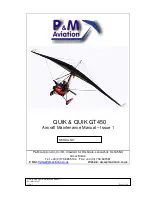
- 12 -
67.
Glue the bottom slice of the foam plug into the bottom of the receiver cut-out hole forming a
base for the receiver recess. Use the marks on its front side and top to orientate it correctly,
ensuring a perfect fit. If you have a top slice, put it aside for later use as a lid over the
receiver.
68.
Next are the servo recesses. If you’re using micro or mini sized servos (metal-geared), we
suggest positioning them about 125mm (5”) outboard of the wing panel’s join line (fin slot).
If standard size servos are used they should be positioned about 15mm (9/16”) outboard
from the wing panel join line (fin slot). In either case the servos should be positioned so that
their control arm is on the outboard side.
69.
Mark a line parallel to the wing panel join line at the appropriate distance outboard (125mm
or 15mm). At this area draw another line that is parallel to the spar and 5mm (3/16”) back
from the edge of the spar slot opening.
70.
Decide whether you want to remove your
servos’ mounting lugs. These are generally
not required for foam gliders and their
removal makes mounting into foam a little
simpler and also enables the servos to be
positioned a little further forward. Base
your decision on the likelihood of
requiring the mounting lugs on the servos
for a different style of model in the future
and the availability and expense of
replacement servo cases.
71.
Lay your servo on top of the wing so that
one of its sides is on the line you marked
parallel to the wing join and one of its
opposite corners (or servo mounting lugs)
is touching the line parallel to the spar slot.
Trace around the servo and then cut around
this outline with a sharp knife all the way
down through the foam. Push out the foam
plug and mark with a vertical line up its
front side for later reference.
72.
Hold the side of your servo against the side
of the foam plug flush with the top surface
of the wing and trace out a line. Repeat this
for all four sides and then cut off a bottom
slice along this outline. Mark the top of the
slice with an “x” for later reference and discard the remaining piece of the plug.
73.
Glue the bottom slice of the foam plug into the bottom of the servo cut-out hole forming a
base for the servo recess. Use the marks on its front side and top to orientate it correctly,
ensuring a perfect fit.
74.
Repeat this process for the second servo recess on the other side of the wing.
75.
Mark out the area next to the servo recess required to accommodate the servo arm and its
movement. It will be about 10mm (3/8”) wide by 20mm (3/4”) long. Cut out a triangular
shaped wedge down to the depth of the servo recess’s floor.
76.
Repeat for the second servo recess on the other side of the wing.
77.
Mark out an area next to the receiver to accommodate the excess length in the battery and
servo leads. An area approximately 30mm by 40mm (1 3/16” by 1 9/16”) is usually plenty.







































